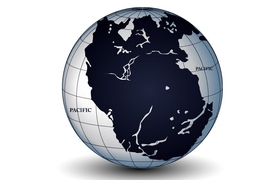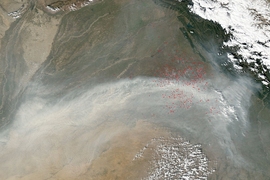Around the globe, ocean surface temperatures have been rising due to global warming, but the seas around Antarctica haven’t changed much. Now, researchers may have discovered why.
The world’s oceans have great potential to absorb and carry heat trapped in the atmosphere due to excess carbon emissions from human activities. Indeed, scientists have observed globally warming seas, particularly near the surface where the heat is entering from the atmosphere.
But the waters around Antarctica aren’t warming like the rest of the world’s oceans. Where the worldwide average sea surface temperature has increased by 0.08 degrees Celsius per decade since 1950, the Southern Ocean has barely felt a thing — only warming by 0.02 C and in some places, cooling. Scientists have been puzzled by this phenomenon, since the polar regions have been feeling disproportionately greater warming. While the Arctic is warming at twice the rate of the rest of the Earth, the waters around Antarctica remain cold, so much so that sea ice has actually grown in some regions.
Now, in a new Nature Geoscience study, researchers from MIT and the University of Washington explain how upwelling from an ancient global ocean current could be the culprit for the Southern Ocean’s delayed warming.
An oceanic conveyor belt
Earth’s climate systems are adept at distributing resources around the globe that are necessary to support life; this includes the dispersal of heat energy. In most oceans, physical mixing of waters can help circulate heat into the ocean’s interior — a deep, cold-water reservoir ideal for storage. However, inherent features of the Southern Ocean serve to resist this process. As strong winds flow around Antarctica, they drive the ocean’s Antarctic circumpolar current (ACC). These currents then draw up deep waters from below to the surface adjacent to the continent, which is south of the ACC. Here, the Southern Ocean is generally stratified with cold, fresh waters on the surface overlaying warmer, salty waters — an atypical characteristic of the world’s seas. This also opposes the transfer of heat into the deep ocean. As a result, the heat absorbed should, more or less, stay near the surface; yet, surface of the Southern Ocean hasn’t been warming.
To track the fate of this excess heat, the team of scientists led by oceanographers John Marshall, the Cecil and Ida Green Professor in MIT’s Department of Earth, Atmospheric and Planetary Sciences (EAPS), and lead-author Kyle Armour from the University of Washington focused their attention on the Earth’s meridional overturning circulation (MOC).
This long, interhemispheric current behaves like a large conveyor belt, connecting the water at the poles and the surface ocean with the deep sea through subduction and upwelling processes. In the Southern Ocean, upwelling dominates. After the water rises between Antarctica and the ACC, the current completes the loop by flowing back toward the equator, making its way to the Arctic where it later cools and sinks. Researchers Armour and Marshall suspected that this upwelling portion of the MOC could be dampening the warming, helping the Southern Ocean to remain cold, says Marshall.
Following the heat
To confirm their suspicions about the MOC’s role in this delayed warming, Armour and Marshall used a combination of observational data from Argo floats, a global free-drifting ocean sampling array; ships; and satellites, along with circulation models to trace how the heat moved through the ocean. What they saw was a displacement of heat — not vertically into the deep ocean around Antarctica but horizontally over the surface of the ocean northward. The currents circulated the heat out of the Southern Ocean towards the equator. There, just north of the ocean’s Antarctic Circumpolar Current, Armour and Marshall observed significant warming, both in the surface and deep waters — a region known to mix and subduct water on a large scale.
“That was a key piece of evidence that showed it must be this meridional overturning circulation (MOC) at work,” Armour says.
What they found confirmed their suspicions. While strong westerly winds whip around Antarctica, they blow the warming surface water all around the continent northward toward the equator. At the same time, these winds draw up deep seawater, which replaces the water that’s flowing out of the Southern Ocean. However, this is not the only place that upwelling and water overturning occurs in the world’s seas. In some places like the west coast of the Americas, water is pulled up from a depth of a few hundred meters, but the water in the Southern Ocean is unique, rising from several thousand meters (close to 2 miles) below the surface.
“One way to think about this process is that the water that’s coming up in the Southern Ocean originated in the North Atlantic [where cold water sinks]. And it took a long time to trace the world’s oceans and then upwell. It’s very deep, old water, which hasn’t seen the effects of global warming,” Armour says. “And so, you constantly have this flux of old water toward the continent at depth. That water comes up to the surface and then flows northward, making up the overturning circulation.”
And as Marshall explains, “The reason that we think that surface temperatures don’t rise as much around Antarctica as they do in the north is because this old water is upwelling from depth and that quenches the warming signal [in the Southern Ocean].” This then leads to an influx of heat into surface waters because the atmosphere is continuing to warm while the Southern Ocean’s temperatures remain stable.
Other scientists have proposed alternative theories to try to explain this delayed warming. One is that climate change is causing glaciers to melt and more rain to fall over the Southern Ocean. This results in a freshening and cooling of surface waters, further stratifying the sea. But Armour and Marshall showed that this process isn’t large enough to cancel out the greenhouse gas warming effect. Another suggestion was that ozone depletion over Antarctica speeds up the westerly winds, driving water equatorward. Initially, this serves to cool the top ocean layer and expand sea ice, but ultimately, it enhances the overturning circulation — pulling warm water up at an increased rate, negating the observed Antarctic cooling.
Armour and Marshall then narrowed down the reason for the Southern Ocean’s delayed warming using models. They found that climate circulation models — which included both the ocean and the atmosphere — captured the observed warming well, and so they honed in on the ocean component, where they hoped to see the same effect.
“We were able to isolate the ocean-part of the story — controlling much more cleanly that which was going on in the atmosphere — and show that we got the same general patterns as in the observations,” says Marshall. This provided another clue that they were on the right track with the meridional overturning circulation. Lastly, the researchers added a passive tracer to the ocean models, which behaved like a surface injection of heat, but didn’t change the currents or water features, similar to dropping paper dots into a stream.
Each of these experiments produced the same result. “It’s not just the observations that show this [delayed warming]. We ran climate models and all of them tend to show a slower warming of the Southern Ocean. It eventually does warm up quite a bit, almost as much as the Arctic in fact, but it takes many, many centuries, even thousands of years to get there,” Armour states. Backed by this evidence, Armour and Marshall could say that the meridional overturning circulation was likely responsible for Southern Ocean’s behavior.
Armour was pleasantly surprised by how clean the answer turned out to be. “It was so robust through a huge range of complexity — starting from the climate systems, through very sophisticated climate models, all the way to very simple ocean-only models. This kind of robustness and simplicity was what we were hoping for, but it’s always surprising things work out this nicely.”
“I thought it [the study] was brilliant,” said John Fyfe, a Senior Research Scientist with Environment and Climate Change Canada, who was not involved with the research. “I think it will become the textbook on the role that anthropogenic forcing [plays] in the pattern of ocean temperature changes in the Southern Ocean, which has been perplexing for some time.”
One of the takeaways, according to both Armour and Marshall, was the need to understand how differently the Arctic and Antarctic react to climate change. “You can’t directly compare the Arctic to the Antarctic when you’re talking about global warming because the greenhouse gas effect has occurred on top of very different background ocean circulations,” says Armour. “And that’s what we’re seeing here, the ocean circulation — on top of which global warming is happening — is really key in setting these [regional] patterns of warming.”
Implications for Antarctic ice
The next step is to evaluate if cooling surface waters around Antarctica could impact the Southern Ocean’s observed sea ice expansion and, if so, how. Marshall says that, overall, Antarctic sea ice isn’t significantly trending upward or down, but rather remaining constant.
Marshall and a recent MIT EAPS graduate Yavor Kostov PhD '16 postulate that stronger westerly winds around Antarctica could enhance this transport of heat northward, facilitating sea ice growth. “The argument,” Armour says, “is that because of upwelling around Antarctica, the surface ocean hasn’t been warming very quickly, which means that, when you do change the winds, you could potentially explain the last several decades of cooling on top of this background of very slow warming.”











